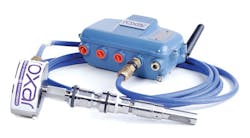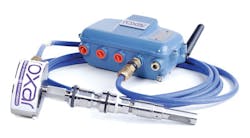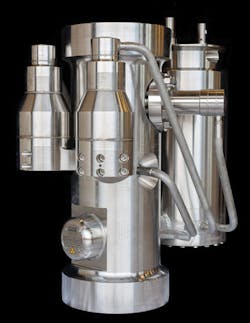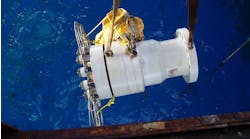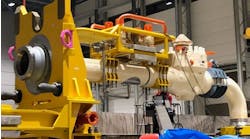Lars Anders Ruden
Emerson Process Management
With the current low oil and gas prices, the efficient and cost-effective delivery of hydrocarbons from reservoir to refinery has never been more important. And yet the current price-sensitive environment also requires advanced but cost-effective topsides and subsea technologies that are flexible, can be implemented quickly and cheaply, and deliver enhanced reservoir recovery.
The success of maximizing asset returns depends on operators’ ability to characterize and understand reservoirs and generate accurate production information to guide decision-making. Questions operators ask include: How are my wells performing? Are there any conditions that affect my assets and the production flow? How do I keep my assets working for the full life of the field with the same efficiency?
These questions and the need for answers remain the same and yet today operators must make their investments go further than ever before. Against this backdrop, this article will look at two principal threats to production and flow assurance integrity - sand and water. It will also argue for a more modular and flexible approach to flow metering at a time when operators are continually keeping an eye on the bottom line.
Sand erosion
Sand erosion is one of the most significant threats to oil and gas production today. It can clog production equipment, erode completion components, and interfere with infrastructure - all with a negative impact on production rates.
Furthermore, with an increased reliance on aging assets and more mature fields in lieu of newer, more expensive developments, there is an increased risk of rising water production and a greater risk of erosion damage from sand particles. Operators need access to a complete production system, delivering intelligent real-time information and operating alongside existing instrumentation.
It is with these issues at the forefront that Emerson, alongside asset integrity management provider Stork, installed its new sand erosion wireless monitoring solution - the Roxar SandLog wireless transmitters - on a major North Sea operator’s platform.
The new wireless devices will provide flexible, cost-effective, and accurate online monitoring of sand erosion from the field, helping to extend equipment life and increase production from reserves. It will also meet today’s operator criteria for technologies with cost-effective implementation, a standardized and integrated technology, and increased production performance.
For example, the wireless transmitters will significantly reduce installation costs compared to wired online systems and enable monitoring in previously inaccessible areas. In terms of standardization, the transmitters are also just one element of a complete asset integrity system that includes corrosion monitoring transmitters, a windows-based field monitoring system and access to the WirelessHart networks, a wireless sensor networking technology.
The collaboration between Emerson and Stork marks the first installation of such wireless monitors in the UK continental shelf and combines Stork’s broad monitoring solutions service offering, in-depth knowledge, and track record alongside the sand erosion monitoring system. The result for operators will be improved reservoir recovery and reduced threats to production.
Water and salinity
Formation water is another significant threat to flow assurance today with there being little room for error or production slow-down due to declining profit margins. Undetected formation water and water coning in gas and gas/condensate fields, for example, can lead to hydrates, scale, and corrosion, and - in worst-case scenarios - well shutdowns.
With many oil and gas wells being produced over a wider range of process conditions with increased exposure to saline water, there is therefore a need to detect changing fluid composition and water salinity in order to determine whether formation water is entering the flow and whether injection rates of scale and corrosion inhibitors should be changed.
To this end, new technologies have been developed around the subsea wet gas meter that improves measurement uncertainty and salinity measurement as well as extending the operating range for such meters. Such meters have previously been installed on fields such as the Independence Hub in the Gulf of Mexico and the Ormen Lange field in the North Sea.
New developments include microwave-based measurements and multi-variate analysis functionality that detects changes in water content of the flowing well at as little as 0.2 ppm - sensitivity that is comparable to less than a droplet of water finely distributed in a volume equal to that of four car fuel tanks.
Another development is a modular salinity measurement system that enables the precise measurement of water and salt content - vital for optimizing and prolonging production and keeping operating costs down.
The technology, that includes a built-in salinity measurement system, enables the early detection of formation water breakthrough at extreme gas void fraction and measures and quantifies formation water.
Yet, due to large flow condition variations, no single measuring method will be optimized for all situations. Therefore, the focus has been on a modular system with a range of sensors and measurement methods to cover all operational needs.
Some methods, for example, specifically target liquid film or cross sectional measurements of tiny droplets in wet gas applications, while others are intended for general multi-phase flow. They can also be used separately or in combination to cover the desired range.
It is through this flexible approach that the operator criteria of easy implementation and standardized technologies can be realized as well as ultimately improved production.
A flexible approach
Both of these solutions - that counteract sand and water - also require a more modular and flexible approach if they are to be fully effective in securing flow assurance today.
When it comes to the measurement of flow rates including water, for example, many operators simply cannot afford a multi-phase meter per well. They look for metering solutions that produce much of the same output but are also field proven so as to reduce risk.
There is a need for flexible, modular, and cost-effective software and multi-phase metering products targeted at multiple segments and based around existing technology platforms.
With a new modular solution around the current multi-phase meter 2600 to be launched later this year, the company is developing a multi-phase metering scenario where the various modules can be mixed and matched in a variety of configurations, depending on the application and measurement needs.
Different applications, for example, might include wellhead applications, gas-liquid/oil-water separators, and fiscal metering; and products might include high and low range multi-phase and water cut meters for single and two-phase flows as well as wet gas meters and salinity measurement systems.
The result will be solutions that meet operator challenges of advanced but standardized technologies and that optimize production but reduce risk within strict financial parameters. It will also ensure the greater adoption of multi-phase meters and innovative upstream solutions when arguably they are most in demand.
Challenging times require new approaches and solutions - both topsides and subsea. It is encouraging to see that in flow assurance there are potential answers.
